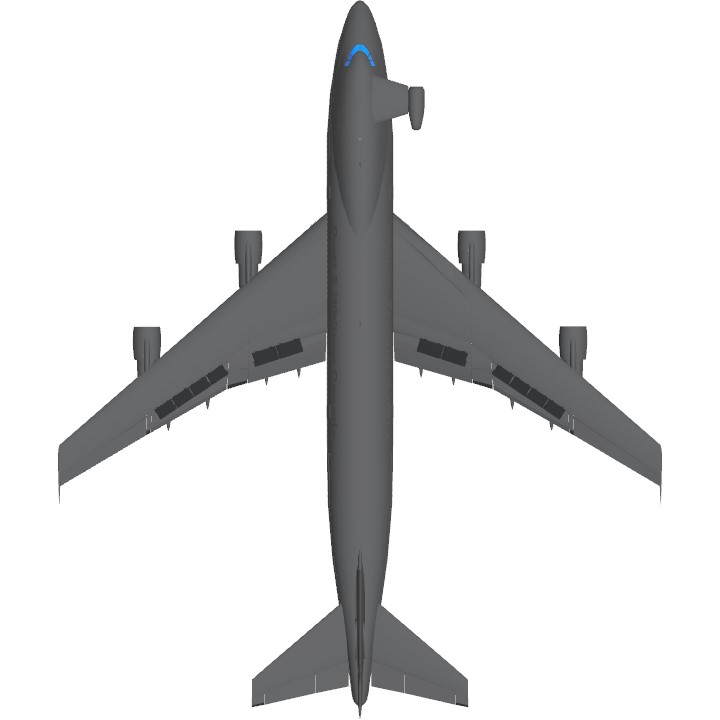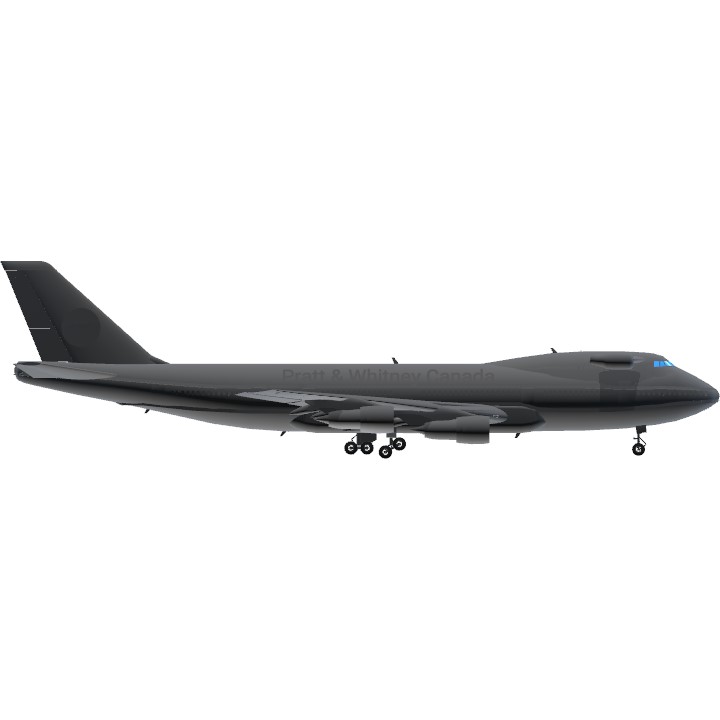Ver.3/4 Of the P&W 747SP Testbed
747 Model From HurricaneD
Wiki:The Boeing 747SP (for Special Performance) is a shortened version of the Boeing 747 wide-body airliner, designed for a longer range. Boeing needed a smaller aircraft to compete with the McDonnell Douglas DC-10 and Lockheed L-1011 TriStar tri-jet wide-bodies, introduced in 1971/1972. Pan Am requested a 747-100 derivative to fly between New York and the Middle East, a request also shared by Iran Air, and the first order came from Pan Am in 1973. The variant first flew on July 4, 1975, was approved by the Federal Aviation Administration on February 4, 1976, and entered service that year with Pan Am.
The SP is 184 feet 9 inches (56.31 m) in length, 47 feet (14 m) shorter than the original 747 variants. Its main deck doors are reduced to four on each side to suit its lower capacity. The vertical and horizontal tailplane are larger and its wing flaps have been simplified. With a 700,000-pound (320 t; 320,000 kg) maximum take-off weight, it can fly 276 passengers in three classes over 5,830 nautical miles [nmi] (10,800 km; 6,710 mi). One 747SP was modified into the Stratospheric Observatory for Infrared Astronomy (SOFIA). The last example was delivered in 1987; some were converted to transports of heads of state. Sales did not meet the expected 200 units, and only 45 aircraft were ultimately produced.
Wiki Development: The idea for the 747SP came from a request by Pan Am for a 747 variant capable of carrying a full payload non-stop on its longest route between New York and Tehran.[3] Joined with Pan Am's request was Iran Air; their joint interest was for a high capacity airliner capable of covering Pan Am's New York–Middle Eastern routes and Iran Air's planned New York-Tehran route[4] (New York to Tehran was the longest non-stop commercial flight in the world for a short time). The aircraft was launched with Pan Am's first order in 1973, and the first example delivered in 1976.[5][6][7]
A shorter derivative of the 747-100, the SP was developed to target two market requirements.[5] The first was a need to compete with the DC-10 and L-1011 while maintaining commonality with the 747,[5] which in its standard form was too large for many routes. Until the arrival of the 767, Boeing lacked a mid-sized wide-body to compete in this segment. The second market requirement was an aircraft suitable for the ultra-long-range routes emerging in the mid-1970s following the joint request. These routes needed not only longer range, but also higher cruising speeds. Boeing could not afford to develop an all-new design, instead opting to shorten the 747 and optimize it for speed and range, at the expense of capacity.[8]
The last 747SP, built in 1987 for Abu Dhabi Amiri Flight
Originally designated 747SB for "short body", it was later nicknamed "Sutter's balloon" by employees after 747 chief engineer Joe Sutter.[9] Boeing later changed the production designation to 747SP for "special performance", reflecting the aircraft's greater range and higher cruising speed.[10] Production of the 747SP ran from 1976 to 1983. However, a VIP order[5] for the Abu Dhabi Amiri Flight led Boeing to produce one last SP in 1987. Pan Am was the launch customer for the 747SP, taking the first delivery, Clipper Freedom, on March 5, 1976.[10]
The 747SP was the longest-range airliner available until the 747-400 entered service in 1989. Despite its technical achievements, the SP never sold as well as Boeing hoped.[5] Increased fuel prices in the mid-1970s to early 1980s, the SP's heavy wings, high cost,[5] and reduced capacity, and the increased ranges of forthcoming airliners[5] were some of the many factors that contributed to its low sales. Only 45 were built, and, of those remaining, most are used by operators in the Middle East. However, some of the engineering work on the 747SP was reused with the development of the 747-300. In the 747SP, the upper deck begins over the section of fuselage that contains the wingbox, not ahead of the wingbox (as is the case with the 747-100 and 747-200). This same design was used in the 747-300 and newer 747-400, resulting in a stretched upper deck.
Wiki Variants: From 2007 until 2022, a specially modified 747SP was used as the Stratospheric Observatory for Infrared Astronomy (SOFIA) astronomical observatory,[5] operated jointly by NASA and Germany's DLR. A former Pan Am and United Airlines aircraft acquired in 1997, its airframe was modified to carry a 2.5-meter-diameter reflecting telescope to high altitude, above 99.9% of the light-absorbing water vapor in the atmosphere. The telescope and its detectors covered a wide wavelength range from the near infrared to the sub-millimeter region; no window material is transparent over this whole range, so the observations were made through a 13 feet (4.0 m) square hole in the port upper quarter of the rear fuselage, aft of a new pressure bulkhead. A sliding door covered the aperture when the telescope was not in use.[11] Astronomers take data and control the instrument from within the normally pressurized cabin. Originally delivered to Pan Am and named "Clipper Lindbergh", the name was displayed in script on the port side of the aircraft.
In September 2022, SOFIA ceased operations after the conclusion of its final mission. The retirement was made both on the grounds of cost and suitability for the requirements of the decade to come.[12] The aircraft was later flown to the Pima Air & Space Museum in Tucson, Arizona, to be put on public display.
Pratt and Whitney Canada Boeing 747SP Testbed
747 Model From HurricaneD
Specifications
Spotlights
- dabestsock 3 months ago
General Characteristics
- Predecessor Boeing 747SP Pratt And Whitney Canada Testbed
- Created On iOS
- Wingspan 194.6ft (59.3m)
- Length 232.0ft (70.7m)
- Height 63.7ft (19.4m)
- Empty Weight 468,091lbs (212,323kg)
- Loaded Weight 777,192lbs (352,528kg)
Performance
- Power/Weight Ratio 0.996
- Wing Loading 82.1lbs/ft2 (401.0kg/m2)
- Wing Area 9,462.0ft2 (879.1m2)
- Drag Points 34185
Parts
- Number of Parts 905
- Control Surfaces 5
- Performance Cost 4,034





@PannerTerkins not build request but I found a cool version of this
@PannerTerkins can you make this build with @mapa and I glad I found someone who great at building aircraft and restyling them I think the word is i should use lol
747SP
@PannerTerkins ok
@dabestsock yup!